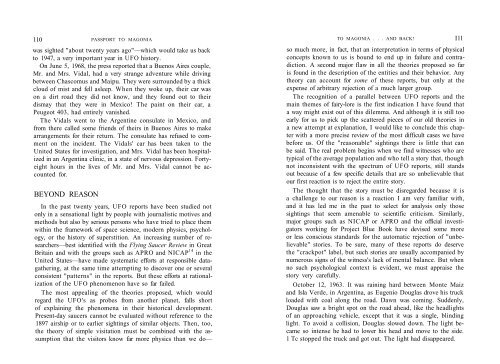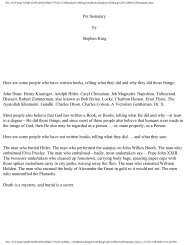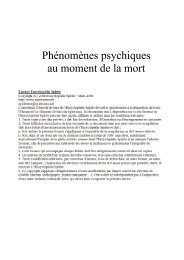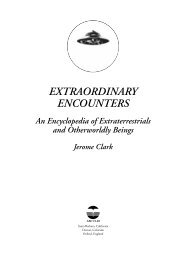You also want an ePaper? Increase the reach of your titles
YUMPU automatically turns print PDFs into web optimized ePapers that Google loves.
110 PASSPORT TO MAGONIA<br />
was sighted "about twenty years ago"—which would take us back<br />
to 1947, a very important year in UFO history.<br />
On June 5, 1968, the press reported that a Buenos Aires couple,<br />
Mr. and Mrs. Vidal, had a very strange adventure while driving<br />
between Chascomus and Maipu. They were surrounded by a thick<br />
cloud of mist and fell asleep. When they woke up, their car was<br />
on a dirt road they did not know, and they found out to their<br />
dismay that they were in Mexico! The paint on their car, a<br />
Peugeot 403, had entirely vanished.<br />
The Vidals went to the Argentine consulate in Mexico, and<br />
from there called some friends of theirs in Buenos Aires to make<br />
arrangements for their return. The consulate has refused to comment<br />
on the incident. The Vidals' car has been taken to the<br />
United States for investigation, and Mrs. Vidal has been hospitalized<br />
in an Argentina clinic, in a state of nervous depression. Fortyeight<br />
hours in the lives of Mr. and Mrs. Vidal cannot be accounted<br />
for.<br />
BEYOND REASON<br />
In the past twenty years, UFO reports have been studied not<br />
only in a sensational light by people with journalistic motives and<br />
methods but also by serious persons who have tried to place them<br />
within the framework of space science, modern physics, psychology,<br />
or the history of superstition. An increasing number of researchers—best<br />
identified with the Flying Saucer Review in Great<br />
Britain and with the groups such as APRO and NICAP 14 in the<br />
United States—have made systematic efforts at responsible datagathering,<br />
at the same time attempting to discover one or several<br />
consistent "patterns" in the reports. But these efforts at rationalization<br />
of the UFO phenomenon have so far failed.<br />
The most appealing of the theories proposed, which would<br />
regard the UFO's as probes from another planet, falls short<br />
of explaining the phenomena in their historical development.<br />
Present-day saucers cannot be evaluated without reference to the<br />
1897 airship or to earlier sightings of similar objects. Then, too,<br />
the theory of simple visitation must be combined with the assumption<br />
that the visitors know far more physics than we do—<br />
TO MAGONIA . . . AND BACK!<br />
so much more, in fact, that an interpretation in terms of physical<br />
concepts known to us is bound to end up in failure and contradiction.<br />
A second major flaw in all the theories proposed so far<br />
is found in the description of the entities and their behavior. Any<br />
theory can account for some of these reports, but only at the<br />
expense of arbitrary rejection of a much larger group.<br />
The recognition of a parallel between UFO reports and the<br />
main themes of fairy-lore is the first indication I have found that<br />
a way might exist out of this dilemma. And although it is still too<br />
early for us to pick up the scattered pieces of our old theories in<br />
a new attempt at explanation, I would like to conclude this chapter<br />
with a more precise review of the most difficult cases we have<br />
before us. Of the "reasonable" sightings there is little that can<br />
be said. The real problem begins when we find witnesses who are<br />
typical of the average population and who tell a story that, though<br />
not inconsistent with the spectrum of UFO reports, still stands<br />
out because of a few specific details that are so unbelievable that<br />
our first reaction is to reject the entire story.<br />
The thought that the story must be disregarded because it is<br />
a challenge to our reason is a reaction I am very familiar with,<br />
and it has led me in the past to select for analysis only those<br />
sightings that seem amenable to scientific criticism. Similarly,<br />
major groups such as NICAP or APRO and the official investigators<br />
working for Project Blue Book have devised some more<br />
or less conscious standards for the automatic rejection of "unbelievable"<br />
stories. To be sure, many of these reports do deserve<br />
the "crackpot" label, but such stories are usually accompanied by<br />
numerous signs of the witness's lack of mental balance. But when<br />
no such psychological context is evident, we must appraise the<br />
story very carefully.<br />
October 12, 1963. It was raining hard between Monte Maiz<br />
and Isla Verde, in Argentina, as Eugenio Douglas drove his truck<br />
loaded with coal along the road. Dawn was coming. Suddenly,<br />
Douglas saw a bright spot on the road ahead, like the headlights<br />
of an approaching vehicle, except that it was a single, blinding<br />
light. To avoid a collision, Douglas slowed down. The light became<br />
so intense he had to lower his head and move to the side.<br />
1 Tc stopped the truck and got out. The light had disappeared.<br />
Ill





